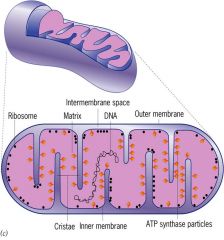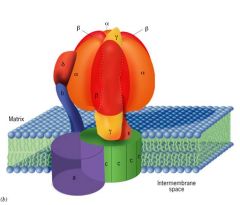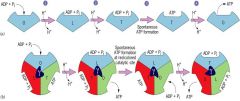![]()
![]()
![]()
Use LEFT and RIGHT arrow keys to navigate between flashcards;
Use UP and DOWN arrow keys to flip the card;
H to show hint;
A reads text to speech;
26 Cards in this Set
- Front
- Back
|
draw a mitochondrial structure
|

mitochondria
|
|
|
where are electron carriers found?
|
in the mitochondrial inner membrane
|
|
|
where does major free energy loss occur?
|
through complex 1,3, 4
|
|
|
what happens as electrons pass through various electron carriers in complexes?
what will happen next? |
they lose energy
after this, the proteins surrounding the complexes take up the energy and couple it to the pumping of protons out of the membrane accross the inner mitochondrial membrane to form an ion gradient |
|
|
what charge will the matrix possess when ions become pumped?
|
negative
|
|
|
name what is in each of the 4 complexes?
|
1)nadh dehydregenase
2)cytochrome bc1 3)succinate dehydrogenase 4)cytochrome c oxidase ubiquinone occurs as a poll of molecules dissolved in the lipid bilayer cytochrome c is a soluble protein in the intermembrane space |
|
|
when ions are pumped out of the matrix of the mitochondria and into the inner membrane space, what happens?
|
a ph with log of .5-1 results
-160mV |
|
|
how can the negative charged matrix be physically realized?
|
you can treat it with a positive fluorescent dye that will that will bind to the negative matrix and cause it to fluoresce.
|
|
|
what do the pH difference and the potential difference create in mitochondria?
|
a proton motive force...an electrochemical gradient which protons can diffuse back into the matrix
|
|
|
how do things get accross the inner mitochondrial membrane in mitochondria?
major route? |
-by transport proteins or pumps
-there are no channels!!! -atp synthase is the major route |
|
|
DNP
|
Dinitrophenol uncouples the electron transport chain to atp synthesis
DNP binds to protons as they go down their gradient energy is lossed as heat instead of being transferred to atp production |
|
|
importance of mammalian fat adipose cells
|
uncoupling of atp synthesis during the electron transport chain occurs
-this energy is given off as heat and keeps animals warm |
|
|
what enzyme does the proton gradient in mitochondria use to generate atp?
|
atp synthase
|
|
|
2 main parts of atp synthase and there main function?
|
F0 stalk crosses the inner mitochondrial membrane..functions for transport of stuff
-and the F1 sticks out into the matrix functions for atp synthesis |
|
|
what will happen if the F1 head is removed from atp synthase?
|
it will stop atp synthesis and cause protons to leak into the matrix
|
|
|
name the makeup, with subunits, of atp synthase
|

F1 spherical “head”
5 subunits: 3 alpha 3 beta – catalytic site 1 delta 1 gamma – central site 1 epsilon F0 stalk 3 subunits: 1 a 2 b 12 c |
|
|
describe the binding change mechanism proposed by boyer in 1979
|

1) the movement of protons is not directly coupled to atp production, but is used to cause the unbinding of newly formed atp.
....atp and pi bind to the catalytic site of atp synthase (it has high affinity for atp so it will form this) ...the release of energy from the proton movement is used to drive the conformational change that will release this atp 2)3 catalytic sites with one on each of the beta subunits 3)rotational catalysis with the F1 head adopting the three possible conformations |
|
|
how many catalytic sites are there?
how many cycles and what are they? |
3...one on each beta subunit
“loose”, L conformation – loosely binds ADP + Pi “tight” , T conformation, T - ADP + Pi “squeezed” to create tightly bound ATP “open”, O conformation – low affinity for nucleotides, releases ATP |
|
|
which subunit contracts the beta subunit and causes it to change its conformation?
|
gamma
|
|
|
what will happen in isolated f1 heads?
|
they cannot rotate and will thus be locked into showing a certain affinity for ATP, adp and Pi
|
|
|
what happens if the if gamma subunit spins the opposite dirrection and how can this be viewed?
|
if atp is added and a genettically enginnereed substrate is added to the beta subunit, atp hydrolysis will result and it will go in reverse
actin filimant is added to gamma subunit and his tag is added to Beta subunit |
|
|
go over hw atp synthase functions in detail from lecture notes
|
do it
|
|
|
rotation of the c subunit drives rotation of what subunit?
|
gamma
|
|
|
which subunits move
|
only gamma and C
|
|
|
how many protons to drive one full revolution of the c cylinder
|
12 protons...each proton rotates it 30 degrees
one atp created for 4 protons transferred to the matrix |
|
|
describe the path of protons in atp synthase
|
1)enters subunit a from the intermembrane space
2)goes on the merigoround of c subunit 3) reenters subunit a and goes back to matrix |

